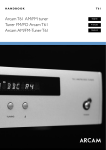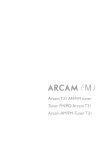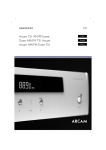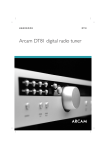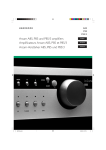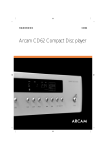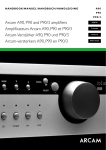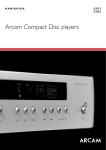Download Arcam T61 Operating instructions
Transcript
HANDBOOK T6 1 Arcam T61 AM/FM tuner T61 issue2.id 1 05/30/02, 7:43 PM Safety guidelines CAUTION ATTENTION RISK OF ELECTRIC SHOCK DO NOT OPEN RISQUE DE CHOC ELECTRIQUE NE PAS OUVRIR CAUTION: To reduce the risk of electric shock, do not remove cover (or back). No user serviceable parts inside. Refer servicing to qualified service personnel. WARNING: To reduce the risk of fire or electric shock, do not expose this apparatus to rain or moisture. The lightning flash with an arrowhead symbol within an equilateral triangle, is intended to alert the user to the presence of uninsulated ‘dangerous voltage’ within the product’s enclosure that may be of sufficient magnitude to constitute a risk of electric shock to persons. The exclamation point within an equilateral triangle is intended to alert the user to the presence of important operating and maintenance (servicing) instructions in the literature accompanying the product. 8. Cleaning Unplug the unit from the mains supply before cleaning. The case should normally only require a wipe with a soft, damp, lint-free cloth. Do not use paint thinners or other chemical solvents for cleaning. We do not advise the use of furniture cleaning sprays or polishes as they can cause indelible white marks if the unit is subsequently wiped with a damp cloth. 9. Power sources Only connect the appliance to a power supply of the type described in the operating instructions or as marked on the appliance. 10. Power-cord protection CAUTION: In Canada and the USA, to prevent electric shock, match the wide blade of the plug to the wide slot in the socket and insert the plug fully into the socket. Power supply cords should be routed so that they are not likely to be walked on or pinched by items placed upon or against them, paying particular attention to cords and plugs, and the point where they exit from the appliance. Important safety instructions 11. Grounding This product is designed and manufactured to meet strict quality and safety standards. However, you should be aware of the following installation and operation precautions: Ensure that the grounding means of the appliance is not defeated. 12. Power lines 1. Take heed of warnings and instructions Locate any outdoor antenna/aerial away from power lines. You should read all the safety and operating instructions before operating this appliance. Retain this handbook for future reference and adhere to all warnings in the handbook or on the appliance. 13. Non-use periods 2. Water and moisture The presence of electricity near water can be dangerous. Do not use the appliance near water – for example next to a bathtub, washbowl, kitchen sink, in a wet basement or near a swimming pool, etc. 3. Object or liquid entry Take care that objects do not fall and liquids are not spilled into the enclosure through any openings. Liquid filled objects such as vases should not be placed on the equipment. 4. Ventilation Do not place the equipment on a bed, sofa, rug or similar soft surface, or in an enclosed bookcase or cabinet, since ventilation may be impeded. We recommend a minimum distance of 50mm (2 inches) around the sides and top of the appliance to provide adequate ventilation. 5. Heat Locate the appliance away from naked flames or heat producing equipment such as radiators, stoves or other appliances (including other amplifiers) that produce heat. If the unit has a standby function, a small amount of current will continue to flow into the equipment in this mode. Unplug the power cord of the appliance from the outlet if left unused for a long period of time. 14. Abnormal smell If an abnormal smell or smoke is detected from the appliance, turn the power off immediately and unplug the unit from the wall outlet. Contact your dealer immediately. 15. Servicing You should not attempt to service the appliance beyond that described in this handbook. All other servicing should be referred to qualified service personnel. 16. Damage requiring service The appliance should be serviced by qualified service personnel when: A. the power-supply cord or the plug has been damaged, or B. objects have fallen, or liquid has spilled into the appliance, or C. the appliance has been exposed to rain, or D. the appliance does not appear to operate normally or exhibits a marked change in performance, or E. the appliance has been dropped or the enclosure damaged. 6. Climate The appliance has been designed for use in moderate climates. Safety compliance 7. Racks and stands This product has been designed to meet the IEC 60065 international electrical safety standard. Only use a rack or stand that is recommended for use with audio equipment. If the equipment is on a portable rack it should be moved with great care, to avoid overturning the combination. T61 2 T61 issue2.id 2 05/30/02, 7:43 PM Using this handbook This handbook has been designed to give you all the information you need to install, connect, set up and use the Arcam T61 tuner. The CR-389 remote control handset supplied with this equipment is also described. Safety Safety guidelines are set out on the inside front cover of this handbook. Many of these items are common sense precautions, but for your own safety, and to ensure that you do not damage the unit, we strongly recommend that you read them. Radio interference All Arcam products have been designed to very high standards of electromagnetic compatibility. However, both CD players and DVD players generate RF (radio frequency) energy. In some cases this can cause interference with FM and AM radio reception. If this is the case, switch the player off or keep the player and its connecting cables as far from the tuner and its aerials as possible. Connecting the player and the tuner/amplifier to different mains sockets can also help to reduce interference. EU countries This product has been designed to comply with directive 89/336/EEC. USA This product complies with FCC requirements. If the equipment causes interference to radio/television reception, which can be determined by switching the equipment off and on, the following measures should be taken: Re-orientate the receiving antenna or route the antenna cable of the receiver as far as possible from this appliance and its cabling. Relocate the receiver with respect to this appliance. Connect the receiver and this appliance to different mains power outlets. If the problem persists contact your Arcam dealer or Arcam Customer Support on +44 (0)1223 203203. Information on radio transmissions A free booklet (number 004-000-00345-4) is available from the U.S. Government called ‘How to Identify and Resolve Radio-TV Interference Problems’ by writing to: The U.S. Government Printing Office Washington, D.C. 20402. The British Broadcasting Corporation publishes a booklet entitled ‘Radio Transmitting Stations’ which contains details of all BBC transmitters in the UK together with other useful hints and tips. This booklet can be obtained on request by sending a large stamped addressed envelope to:- Contents Safety guidelines Important safety instructions Safety compliance 2 2 2 Using this handbook Safety Information on radio transmissions 3 3 3 Installation Positioning the unit Setting up the tuner Connecting to other equipment Connecting to a power supply Custom installation features IR codes 4 4 4 5 5 5 5 Using your tuner Front panel controls Operation Storing a preset Deleting an unused preset RDS: Radio Data System Entering station names manually 6 6 6 7 7 7 7 Using the CR-389 remote control 8 Technical specifications Table of IR commands 9 10 Guarantee 11 On line registration 11 The UK Radio Authority publishes ‘The Radio Authority Pocket Book’ which contains details of all independent radio stations. This booklet can be obtained on request by sending a large stamped addressed envelope to:Holbrook House 14 Great Queen Street Holborn LONDON WC2B 5DG Telephone: 0207 430 2724 Fax: 0207 405 7062 E-mail: [email protected] Internet: http://www.radioauthority.org.uk Engineers Dept. BBC Radio 201 Wood Lane LONDON W12 7TS Telephone: 08700 100 123 Internet: http://www.bbc.co.uk/enginfo/fm_recep T61 3 T61 issue2.id 3 05/30/02, 7:43 PM Installation AUDIO OUTPUTS AERIALS FM 75Ω IR IN POWER INLET 120V 12V TRIGGER IN AM R 230V 2 1 1 GND L AM STEP 2 3 4 5 T61 rear panel 6 7 89 1 Socket for IEC power inlet line 2 Voltage selector switch 3 Remote control input 4 Power On/Standby trigger in 5 AM step switch 6 Audio output phono sockets, two pairs 7 FM coaxial plug 8 Ground socket (for AM loop aerial) 9 AM socket (for AM loop aerial) Positioning the unit FM aerial Always place the tuner on a level, firm surface. An FM aerial is required to receive VHF radio signals. An external FM ribbon aerial is supplied as an accessory. Setting up the tuner AM step switch 5 The AM tuning ‘step size’ needs to be set according to your location. This is done using the switch on the rear panel: set it to 10kHz if you are in North America, or 9kHz anywhere else. This switch also ensures correct reproduction of FM broadcasts for your location. AM aerial An AM aerial is required to receive AM/Medium Wave radio signals. An external AM loop aerial is supplied as an accessory. This should be attached to the AM Antenna inputs with one end and the other to Ground . It does not connected to AM matter which way round this aerial is fitted. Rotate the aerial to discover which position gives the best reception. 9 8 In areas of weak reception or when the receiver is used inside a steel framed building (such as an apartment building) you can use a wire between 3 and 5 metres long to strengthen reception. Mount this high up outside the building, if possible, and connect one end of this wire to the AM antenna input as well as the loop aerial supplied. DO NOT DISCONNECT THE LOOP AERIAL. For optimal FM radio reception a roof or loft mounted aerial is advised. For your own safety it is recommended that a roof top aerial is fitted by an experienced contractor. Your Arcam dealer should be able to put you in contact with an aerial installer. A contractor will be able to tune your aerial to the nearest FM transmitter. In an apartment building an aerial system may already be installed. If this is the case you should have sockets in your home marked FM or VHF (do not use those marked TV). The ‘T’ shaped wire aerial (dipole design) supplied should give reasonably good reception. Mount this aerial as high up as possible on a wall with the elements positioned horizontally. Try each usable wall of the room to see which gives best reception. Use tacks or adhesive tape to secure the aerial in a T shape. The tacks should not come into contact with the internal wire of the aerial. Whether you decide to get an aerial professionally installed or opt to use the supplied aerial it should be connected to the FM Antenna input on the rear of the unit. 7 For use in North America, use an F-type antenna connector; for Europe and other areas, use a female Belling Lee-type coaxial connector. 9 T61 4 T61 issue2.id 4 05/30/02, 7:43 PM Connecting to other equipment Interconnect cables Interconnecting cables are not supplied with this tuner. We recommend high quality cables as inferior quality cables will degrade the sound quality of your system. Please contact your Arcam dealer for details of suitable cables. Connecting your tuner to your amplifier Audio outputs 6 Two pairs of identical outputs are provided. Connect one set to your amplifier’s tuner input or any other line-level input using suitable high quality interconnect cables. Ensure that the left and right audio outputs from the tuner are connected to the same left and right inputs on your amplifier. The second set of audio outputs can be used to connect to a second amplifier set up for ‘multi room’ use, or routed to a tape recorder for ‘off air’ recording. Custom installation features The T61 has a number of useful features that make it ideal for a custom installation, where the tuner is fully integrated with a specialist control system or operated by a programmable remote control. Remote control input 3 A rear panel input that receives modulated carrier based IR commands in RC5 format. The input is suitable for connection to a simple IR eye or to an external controller. Use of this socket disables the front panel IR eye. Trigger input 4 The trigger socket allows the tuner to be remotely switched in and out of standby. The primary front panel POWER switch must be in, ‘on’, for this mode. Apply a +12V DC voltage for ‘on’, the power indicator glows green; 0V for ‘standby’, the power indicator glows red. Connecting to a power supply Note that use of this socket requires a 12V signal before the tuner can be switched fully on. Wrong plug? Infrared (IR) remote commands Check that the plug supplied with the unit fits your supply and that your mains supply voltage agrees with the voltage setting switch (120V or 230V) indicated on the rear panel of the unit . The T61 responds to a set of Philips RC-5 codes in addition to those available on the supplied handset, which is kept simple for ease of use. 2 If your mains supply voltage is different, switch the voltage selector across using a small screwdriver. Mains lead The appliance is normally supplied with a moulded mains plug already fitted to the lead. If for any reason the plug needs to be removed, it must be disposed of immediately and securely, as it is a potential shock hazard when inserted into the mains socket. Should you require a new mains lead, contact your Arcam dealer. Advanced programmable control devices, such as the Philips ‘Pronto’ and other system controllers, can be set up to use the additional codes. Refer to the instructions for your programmable device for details. A table of IR commands is provided on page 10 of this Handbook. Plugging in Push the plug (IEC line socket) of the power cable supplied with the unit into the POWER INLET socket in the back of the unit. Make sure it is pushed in firmly. 1 Put the plug on the other end of the cable into your power supply socket and switch the socket on. T61 5 T61 issue2.id 5 05/30/02, 7:43 PM Using your tuner T61 AM/FM TUNER PRESET 12 BAND 1 RDS MONO STORE 2 3 4 5 67 1 Directly select up to 32 preset stations (16 AM, 16 FM). Press briefly for stations 1–8, press and hold for more than one second for stations 9–16. BAND 2 Selects FM or AM frequency band. The appropriate letters appear on the display. RDS 3 Switches between RDS modes on FM if RDS is available. See the section ‘RDS: Radio Data System’. MONO POWER 8 POWER 9 bk blbm bl Switches the mains power to the unit on or off. Power indicator bm This glows green to show that the unit is ready for use. The indicator glows red in standby mode when the tuner is switched off via the remote control, or configured in a custom installation. Operation The T61 radio tuner can be controlled from the front panel buttons or from the remote control handset (see ‘Using the remote control’). Tuning to a station 4 Pressing the TUNING button toggles between the two tuning modes of the unit – ‘Preset’ or ‘Tune’. The selected mode is briefly shown in the display. In mono mode, FM muting is suppressed when tuning between stations and the ‘FM MUTE’ indicator is switched off. In Preset mode, press the and buttons on the front panel (or < or > on the remote control handset) to cycle up and down the preset stations. 5 The STORE button allows you to assign radio stations to preset numbers. See the instruction ‘Storing a preset’ Preset indicator 6 Indicates the number of the preset currently selected. Signal strength 7 A seven step indicator showing the strength of a tuned station. In FM generally 5 or more bars are required for good reception and to lock onto RDS data. Tuning 8 Switches between Tune and Preset mode for the down/up buttons. Preset mode is indicated by PRESET on the display. Tune down/up 9 Used to either scroll through presets, or to tune up and down the broadcast band, depending on the current mode. See Tuning to a station for more details. Frequency/ RDS display T61 issue2.id MHz Selects mono or stereo output. Stereo is only available on FM radio stations. If a weak station is received in stereo the background hiss can be reduced (and in most cases eliminated) by selecting ‘MONO’. STORE T61 6 FM 103.50 TUNING Front panel Controls Preset Memory buttons FM MUTE STEREO SIGNAL TUNED Preset mode ! " See ‘Storing a preset’ and ‘Deleting unused presets’, below. Tune mode Automatic tuning: Press the and buttons on the front panel (or < or > on the remote control handset) for longer than one second to engage automatic tuning. The tuner searches for a radio station signal of sufficient strength and stops. To skip to the next station, press one of the buttons again. Automatic tuning is available for both the FM and AM bands. ! " Manual tuning: Tap the and buttons for manual tuning. This can be used for tuning to a specific frequency. It is also useful if you are trying to select a station that is too weak for the auto search mode. ! " Regardless of the mode used to tune your T61, when it is accurately tuned to a station ‘TUNED’ lights up in the display. bk Indicates the frequency of the selected station in MHz (FM) or kHz (AM). Also displays RDS information when present. 6 05/30/02, 7:43 PM Storing a preset RDS: Radio Data System To store a preset, tune to the radio station you wish to store. Press the STORE button: this causes ‘PRESET STORE’ to flash in the display. Now select the preset number you wish to assign to the station using the preset memory buttons or the and buttons on the front panel. Press the STORE button again. The Arcam T61 supports RDS Programme Service and RDS Radio Text on FM broadcasts. Once the preset is stored, the display reverts to show the station name (if RDS information is transmitted) or its frequency. Press the RDS button to view any RDS text information (if a station is not transmitting text information, the display briefly indicates ‘NO TEXT’ and reverts to show the station name). To quit the memory function without storing a preset, leave the tuner controls untouched for ten seconds. It is also possible to overwrite a stored station by saving another in its place. There are thirty presets available for FM use and sixteen for AM use. Press RDS again to display the station’s frequency. ! " Your presets are retained when the T61 is disconnected from the mains supply. Deleting an unused preset Press the RDS and STORE buttons on the front panel, wait about three seconds, then select the preset number you want to delete using the and buttons, followed by the RDS button. ! " The display briefly shows ‘DELETED’ and ‘– –’ is shown in place of the preset number. You can reactivate a deleted preset number by storing a station in the normal way. When a station carrying RDS information is selected ‘RDS’ lights up in the display and shortly afterwards the station’s RDS name (e.g. ‘BBC R3’) is shown. Pressing RDS a third time returns you to a display of the station name. If the RDS button is pressed while tuned to a non-RDS station, the display shows ‘NO NAME’ for three seconds before reverting to the default display. Entering station names manually Station names can be entered and saved for preset AM stations, and for FM stations where RDS is not available. Station names can be up to eight characters long. First select the band and the preset station you wish to name. Then press and hold the RDS button for more than two seconds. An ‘underscore’ line should appear blinking in the first position of the frequency display area. Use the up and down buttons beneath the display to scroll through the available alphabet, numbers and special characters available until you reach your wanted letter or character. Press the TUNING button to confirm that character. The ‘underscore’ line will then move to the next position. Repeat this process to enter the required name. If you want to edit a character later, use the TUNING button to step along and select it, then use the up down keys as before to change it. When complete, press STORE to enter the name into the preset memory. T61 7 T61 issue2.id 7 05/30/02, 7:43 PM Using the CR-389 remote control FM/DAB MENU (RDS mode) Ensure that the FM mode is selected using the FM/DAB toggle button. The FM LED above the FM/DAB button is lit briefly when FM is selected. This button scrolls through RDS modes, when available. DISP (Display) This button allows you to dim or switch off the tuner display. STANDBY TUNER FM Preset memory buttons These buttons allow access to individual preset stations. To select a preset press the corresponding keypad button. For presets 9–16, press and hold the corresponding preset button for one second. Use the Tune buttons to access FM memory presets 17 to 30. This button switches the tuner (and the amplifier if appropriate) between ‘On’ and ‘Standby’. DAB FM DAB MENU DISP 1–9 2–10 3–11 5–13 6–14 7–15 MODE Tune buttons 4–12 These buttons enable you to scroll through the stored station selections one at a time, or to tune up or down, depending on the Tuning mode. 8–16 BAND BAND This button toggles between FM and AM. SP1 MODE (Tuning mode) This button toggles between PRESET and TUNE modes. SP2 ENTER DISP SEL Amplifier controls These buttons offer basic control over Arcam amplifiers, such as the A65, A75 or A85. PHONO AUX CD TUNER AV DVD VCR TAPE AMPLIFIER RPT PROG DISP CD player controls These buttons offer basic control over Arcam CD players, such as the CD62, CD72 or CD92. CD CR-389 NOTE: DAB (Digital Audio Broadcast) refers to Arcam DAB tuners such as model DT81. Do not place anything in front of the display area on the tuner (where the IR receiver is located), or the remote control may not work. T61 8 T61 issue2.id NOTE: Remember to install the two AAA batteries supplied before trying to use your remote control. 8 05/30/02, 7:43 PM Technical specifications T61 Tuner FM Section Tuning range Frequency steps Presets: total/direct access Sensitivity (IHF) for 50dB S/N ratio Alternate channel selectivity Capture ratio Frequency response Ultimate S/N ratio (CCIR) Mono Stereo Total harmonic distortion Mono Stereo Channel separation (1kHz) Pilot tone suppression Output level 87.5 to 108.0MHz 50kHz 30/16 typically 3µV better than 60dB 1.5dB 20Hz–15kHz ±1dB better than –75dB better than –70dB (96MHz reference, 22.5kHz deviation at 1kHz) better than 0.1% better than 0.2% better than 40dB better than 60dB 700mV at 75kHz deviation AM Section Tuning range: 10kHz step 9kHz step Presets Usable sensitivity IF rejection S/N ratio (30% mod., 50mV I/P) Total harmonic distortion (30% mod., 50mV I/P) Output level 530 to 1710 kHz 531 to 1602 kHz 16 typically 30µV > 36dB > 38dB < 3% 300mV at 70% modulation Control inputs IR remote standard IR in signal level Trigger operating voltage Trigger in polarity Philips RC-5, 36kHz carrier 4–15V pk-pk 9–15V DC tip positive General Output impedance Minimum recommended load Power consumption Size W x D x H Weight net Weight packed Supplied accessories 220Ω 5kΩ 10VA 430 x 290 x 85mm 3.8kg 6.0kg FM dipole aerial AM loop aerial mains lead CR-389 remote control handset and batteries E&OE Continual improvement policy Arcam has a policy of continual improvement for its products. This means that designs and specifications are subject to change without notice. T61 issue2.id 9 NOTE: All specification values are typical unless otherwise stated. T61 9 05/30/02, 7:43 PM Table of IR commands Command Decimal code Standby 17–124 On 17–123 Power toggle 17–12 AM/FM band toggle 17–50 AM band 17–52, 17–46 FM band 17–53, 17–45 Tune down (seek if >1second) 17–31 Tune up (seek if >1second) 17–30 Seek tune down 17–35 Seek tune up 17–34 RDS program 17–62 RDS text 17–63 RDS frequency 17–64 Scroll RDS mode 17–55, 17–61, 17–15 Display on 17–14 Display toggle 17–18 Stereo 17–39 Mono 17–54 Stereo/Mono toggle 17–38 Preset/tune mode toggle 17–37 Preset/tune up 17–32 Preset/tune down 17–33 Store 17–41 Mute on 17–119 Mute off 17–120 Mute toggle 17–13 Preset 1 to 8 (9 to 16 if >1second) 17–1 to 17–8 Preset 9 17–9 Preset 10 to 17 17–110 to 17–117 Preset 18 to 30 17–88 to 17–100 NOTE: The above codes are consistent with the Philips RC-5 standard. T61 10 T61 issue2.id 10 05/30/02, 7:43 PM Guarantee Worldwide Guarantee This entitles you to have the unit repaired free of charge, during the first two years after purchase, at any authorised Arcam distributor provided that it was originally purchased from an authorised Arcam dealer or distributor. The manufacturer can take no responsibility for defects arising from accident, misuse, abuse, wear and tear, neglect or through unauthorised adjustment and/or repair, neither can they accept responsibility for damage or loss occurring during transit to or from the person claiming under the guarantee. The warranty covers: Parts and labour costs for two years from the purchase date. After two years you must pay for both parts and labour costs. The warranty does not cover transportation costs at any time. Claims under guarantee This equipment should be packed in the original packing and returned to the dealer from whom it was purchased, or failing this, directly to the Arcam distributor in the country of residence. It should be sent carriage prepaid by a reputable carrier -– NOT by post. No responsibility can be accepted for the unit whilst in transit to the dealer or distributor and customers are therefore advised to insure the unit against loss or damage whilst in transit. For further details contact Arcam at: Arcam Customer Support Department, Pembroke Avenue, Waterbeach, CAMBRIDGE, CB5 9PB, England Telephone: +44 (0)1223 203203 Fax: +44 (0)1223 863384 Email: [email protected] Problems? If your dealer is unable to answer any query regarding this or any other Arcam product please contact your local distributor. A list of current distributors can be found at www.arcam.co.uk. In the U.K., contact Arcam Customer Support on 01223 203203 or write to us at the above address and we will do our best to help you. On-line registration You can register your Arcam product on line at: www.arcam.co.uk/reg T61 11 T61 issue2.id 11 05/30/02, 7:43 PM PEMBROKE AVENUE, WATERBEACH, CAMBRIDGE CB5 9PB, ENGLAND telephone +44 (0)1223 203203 fax +44 (0)1223 863384 email [email protected] website www.arcam.co.uk Issue 2 T61 issue2.id SH118E 12 05/30/02, 7:44 PM












